India was all but done in early March 1991. But first we thought we’d do a little preparation for our trip into those famous Nepalese mountains.
From Darjeeling you can trek in what I guess are the foothills of the Himalayas and see the giant peaks in the distance. We opted for a three-day trek and after a short bus ride off we went. Looking at the options on the internet there are now roads and lots of organised tours… However back then, we followed the guidelines in one of our books and set off to walk. Our main aim was to trek to Sandakphu to stand on a ridge and watch the sunrise. It took two days walking upwards to get there, one of them walking through cloud. The accommodation along the way was basic and our torches and sleeping bags (with neck-cords tightly pulled for warmth) were used at last. We’d also invested in attractive yak-wool jumpers to stave off the extreme temperatures. Quite a fashion statement.
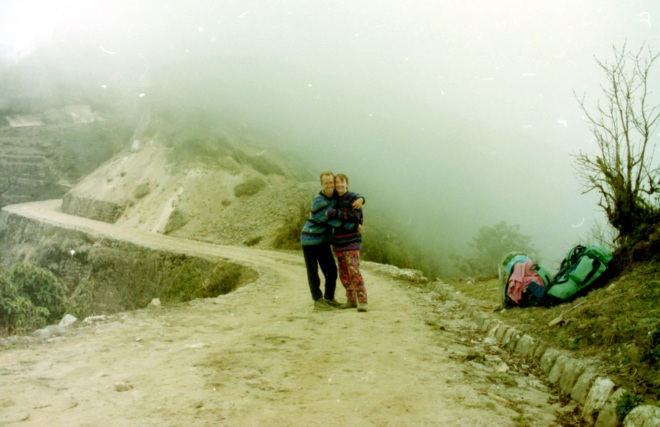
Our accommodation and the views from the ridge at 5am:
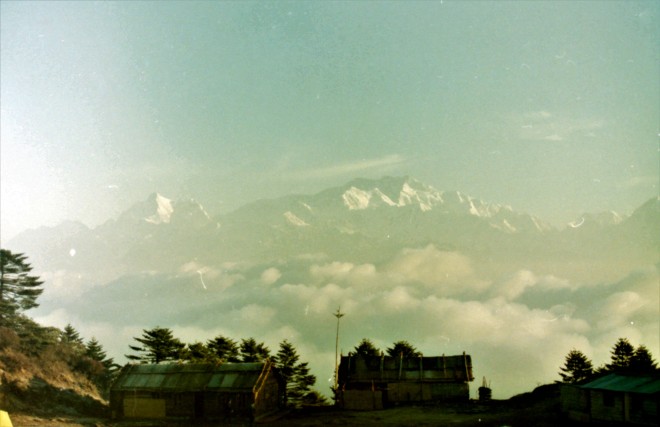
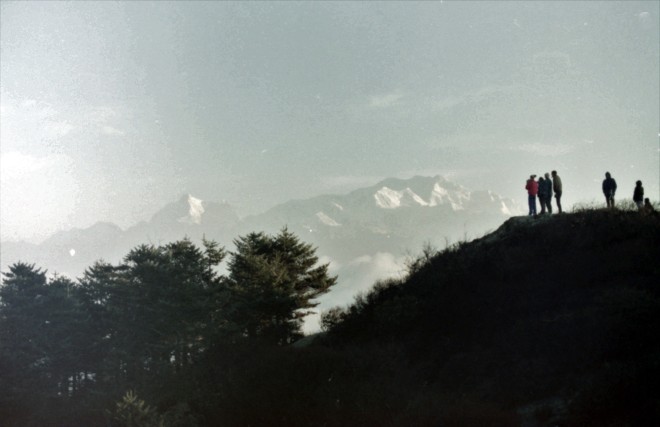
That certainly whetted our appetite for reaching Nepal-proper.
People living in the mountains had very basic living standards but were friendly and welcoming of all us foreigners. Our last night, after hours of unrelenting downhill, was spent at a very pleasant lodge – with many more creature comforts than most. When we arrived and kicked off our walking boots and settled in to our room, we had chocolate biscuits and tea delivered to our room followed later by a disgusting-looking jug each of fermenting grain of some sort. This place was run by an entrepreneur and there was no bill for the room or the continuous hospitality…”just pay what you think it’s worth…”.
There’s one thing I do remember vividly from the next morning . As a popular place, highly recommended in the guidebook, there were many people staying there and there just weren’t enough facilities…and those that there were had certainly been visited too many times during the night by people really not at their best. Suffice to say we had a walk out into the fields (looking for an appropriate bush or two) to meet our needs that day – and that was one time that confirmed for us that anywhere you are in India, even in remote mountain villages, it is very rare that you are never more than a couple of metres away from someone. Not great for those of us who enjoy our privacy at such moments!
Back in Darjeeling we set off on the long journey into Nepal. There were some shenanigans at the border. I have memories of arriving in a bus, transferring to a very crowded taxi (7 travellers and their packs in a standard-size car) for about a mile across the border, money changing and a hot meal in what seemed to be a no-man’s land between the two countries, before getting on the overnight bus… This was just a very basic service bus, with no acknowledgement of the fact it was going for hours. It did stop a few times overnight to pick up people and provisions. There were toilet stops (not for the fainthearted) and chai stops. I don’t think there was much sleeping done. This was the kind of bus with live animals (or, at least, chickens) in the luggage racks. The road was rough, more potholes than tarmac (and deep mud after a wild storm) and mad driving. These roads often have large life-saving slogans painted onto rocks that you pass.
My one abiding memory of the trip was stopping early in the morning to unload some of the provisions – they were piled up on the roof of the bus – why send a truck when a bus with roof-space is going that way anyway? Wooden crates of tomatoes were passed down, but some were dropped – and we had tomatoes raining down the sides of the windows and splatting on the sides of the road. I wish we’d had a video of those moments – but it probably was funnier actually being there (and the colours, sounds etc were probably heightened by the lack of sleep).
Kathmandu was such a relief. We were amazed by just how much more westernised it was than anywhere we’d been in India. Everywhere we went there were little shops geared up for the traveller…and there were things to eat on the menus that looked very tempting for people who’d been eating curries for 3 meals a day for the last 3 months…whether we relaxed our guard, or whether we would have got it anyway, we will never know. But we were both ill. Mark a little bit, and me, seriously. I think I lost a week of my life with only vague recollections of Mark bringing in a doctor, taking medications that he brought, swapping beds as the mattress was soaked through with my feverish sweats and sitting on the toilet and throwing up at the same time…Oh joy. Too much information?
After a week I was able to make it to the International Travel Clinic where I was prescribed more drugs for ‘Traveller’s diarrhoea’. Whilst we were there waiting someone came out of one of the surgery rooms and announced to his partner, “I’ve got Typhoid”, and I said to Mark – I felt last week how he looks now. A couple of months later, after testing in Thailand, it was confirmed that indeed I had had Typhoid.
Anyway, once you feel a bit better you can carry on. We discussed going home, but figured we’d be just feeling weak there and might as well recuperate (and perhaps resume being careful of what we ate) in the exotic locations we found ourselves in…
Kathmandu is (or at least was prior to their devastating earthquake in 2015) a very ornate city with incredible buildings around every corner. We were bowled over. It was as surprising to us as India had been – and significantly different. It was also considerably more touristed too, with the world landing there on a regular basis for their pilgrimages into the mountains.
The temples were fascinating, and not only for us. These were real working temples, not just for tourists, but for locals and some furry friends as well. I could spend hours watching the world go by and the antics of the creatures (locals, monkeys and tourists).
During our explorations we also discovered that Katmandu wasn’t quite the sanitised and westernised place that we initially had got the idea of… Just down by the river all of the town’s rubbish was thrown and it was a hive of activity for all sorts of creatures, including vultures and rats.
Perhaps we’d found this out just a little too late. It was galling because although we’d had a couple of incidents of sickness in India it was always short-lived and manageable…and perhaps we’d been lured into a false sense of familiarity and eaten a tomato or something that hadn’t been peeled or boiled. Hopefully you live and learn… (There might be a message in there for the weird days we’re living through now…complacency).
Whilst in the Kathmandu Valley we had a day trip out to a small town called Bhaktapur (which was also devastated in 2015) where the pace of life was different again. It was a small city that focussed on making clay pots. Everywhere we went there were craftsmen at work.
It was also built with bricks – and if you look closely behind where the potter is working you can see why such a place may have suffered extemely from the trembling earth.
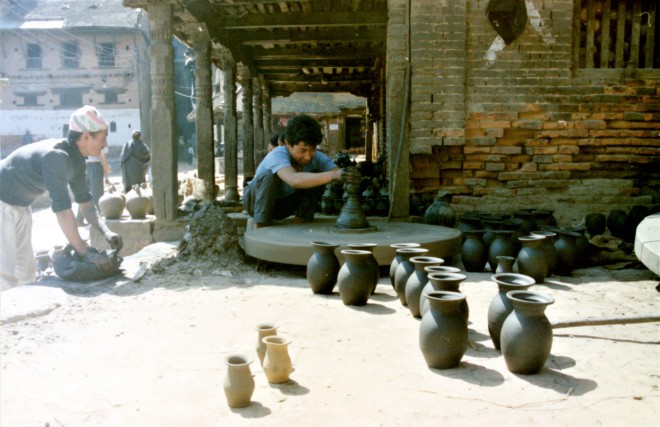
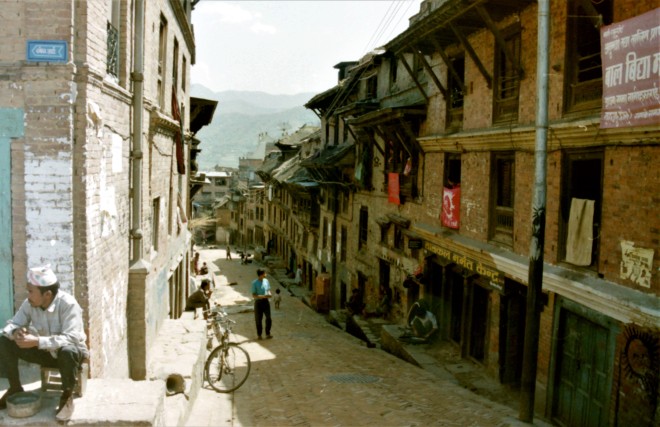
The city square was ornate too, and had developed over time into a real haven for travellers, with coffee shops moving into the tall buildings giving perfect views of the city and mountains in the distance. It also gave great views of the children playing in the streets below. Yes, this was 1991 and not the Victorian ages. I wonder if they still play with hoops and sticks?
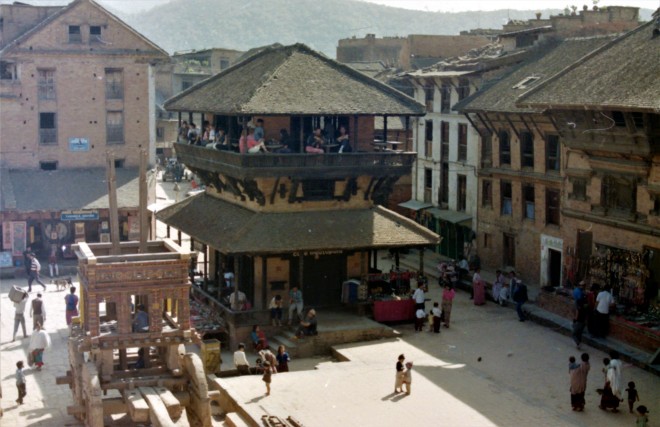
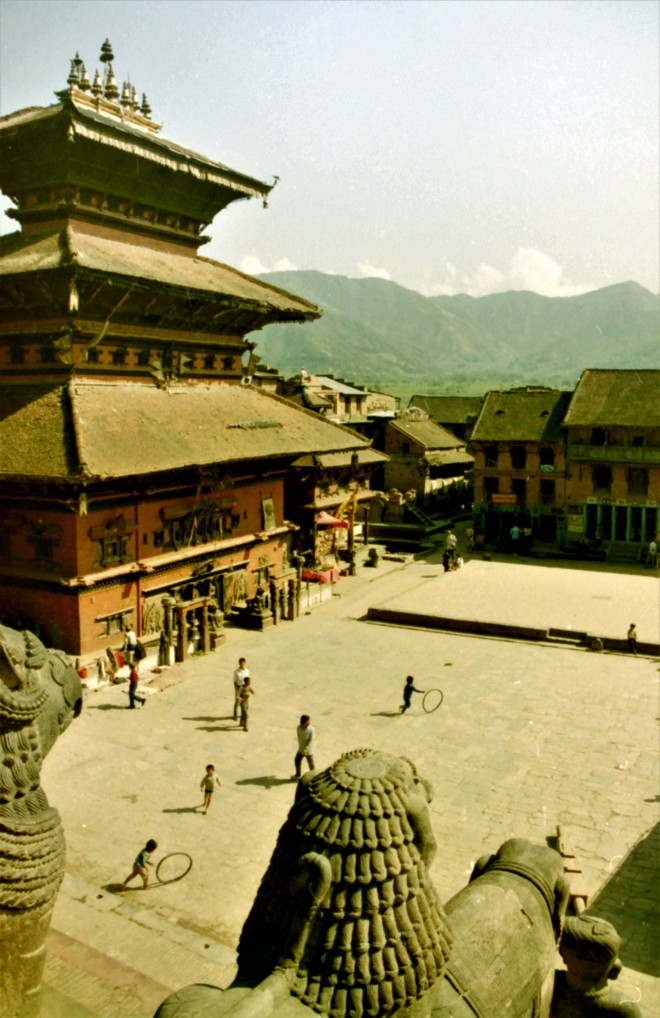
Again the kids were fascinating for us. I loved the fact that they didn’t bother with nappies for the little ones. They either didn’t wear any pants at all or had trousers with no gussets… specially designed open rear ends…to just squat and go. I don’t have a picture of that!
One last thing about Kathmandu…it was one of the few places we’d planned on visiting, so we had shared the main Post Office’s address with family and friends. Back in those days, prior to e-mail and instant messaging (and in a time and place where phone calls were difficult and relatively expensive from small telephone shops) the post was a major lifeline. And for us travellers arriving in a city with a Post Restante was a real treat. Any letters that had been sent for us were filed alphabetically in boxes in the Post Restante room and just waited to be picked up. Usually you showed your passport and were allowed to rifle through the boxes yourself. It was always good to get news from home, and we’d have time sitting outside, with all the other travellers, finding out what was happening in our other world.
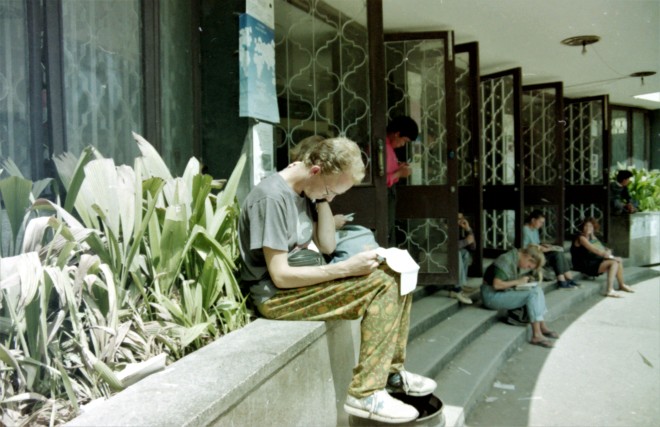
Still no mountains?
Nepal is known for its mountains, but in the South of the country to the West of Kathmandu is a National Park known for its Bengal Tiger community. Who’d have guessed that we went to Nepal to go on safari…?
It was a fairly low-key experience. We stayed in a small village and could just go out for walks down the river and watch the lifestyle of people in a very rural community. And join in with playing with the kids and that world-wide game of skimming stones.
We could also go out for a walk, with a guide, into the park to see the animals. We did just that, with a young guide, armed with a…stick. I loved it. It is such a priviledge and unbelievably uplifting to see animals in their own habitat.
The animals that we saw on this particular walk however, were, the endangered white rhino. I was in my element and see them we did. In retrospect it was probably quite a stupid thing to do – as it appears were many of our experiences during the year – but I was following the guide with Mark behind me and we were creeping through the grasslands and low bushes, happily taking pictures of the things he pointed out to us. He wasn’t ready however, to see a white rhino with its calf just in front of us in a clearing. I know it shocked him because he stopped abruptly, and so did the 2 of us close behind him, crashing into him, then as he disentangled himself from the two of us he scarpered quickly to a safe distance away. It may have looked like a comic-book scenario and it was probably at this point that he told us that white rhinos have quite poor eyesight and to protect themselves and their young they are quite likely to charge anything that moves… and they weigh 3 tons. Strangely enough I didn’t get a picture of that baby rhino and his mum.
We also had a day trip out in a jeep looking for the elusive tiger. We saw other animals but not the big cat. We also went to an elephant sanctuary. The elephants were working animals in the park. There have probably been many discussions about their treatment over the years, but what we saw at that time were animals that appeared to be carefully looked after that were part of everyday life. (They were very cute too).
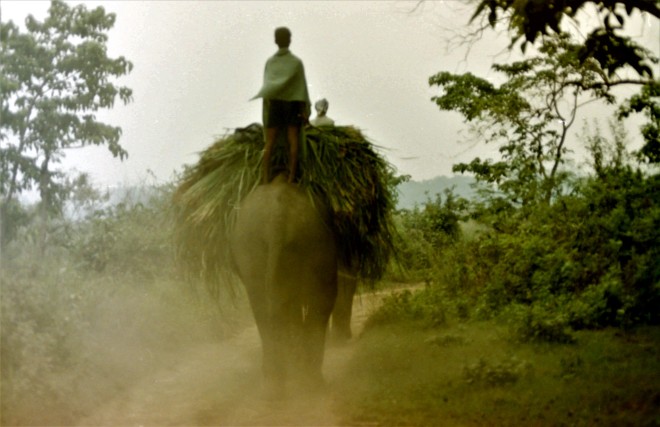
There are some mountains in Nepal too…And we did go to them. And we did trek.
The trek into the mountains starts with a bus ride from Pokhara, which we reached by bus from Kathmandu. One of those two bus rides was one of the most scary experiences of my life. Nepali roads were bad, and driving was extremely bad, and the conditions were such that bits of road had washed away and basically I thought I was going to die.
However, I didn’t and we started the trek to Annapurna base camp. Every day was different. The track was clear (did we have maps? err, no) and I think we only made a mistake once, leading to a couple of hours serious up and down being repeated!).
The scenery was awe-inspiring. The walking was tough.
The first few days were through rice paddies, rhododendron forests (who knew that they were native to the mountains?) and bamboo. There were farms with animals and terraces and small villages with crops drying.
Along the way there were many river valleys that have had bridges built over them to reduce walking times – and ensure they are crossable year round. My family now laugh at me being pathetic and scared about crossing rope-bridges. My fears may have started on some of these long flimsy-seeming bridges crossing pretty wide river valleys. As we walked over one a herd of donkeys came trotting towards us. I didn’t think that I would survive Indiana Jones-style if this bridge was to snap under their weight!
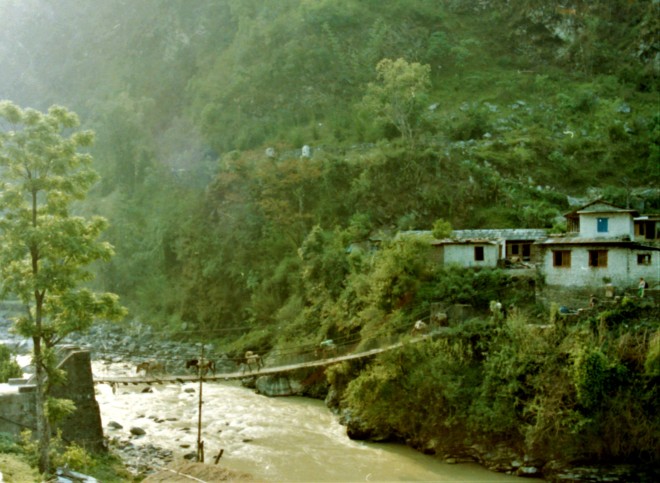
Along the way there were lodges for trekkers. And there were many porters carrying heavy packs. They were often running along the trails, in bare feet and had baskets on their backs suspended on a strap around the front of their forehead. They carried travellers packs (one we saw was carrying probably 8 huge backpacks for an Israeli group that had upset their other porters), tents, food and provisions for the villages and lodges higher up the slopes. Understandably the cost of food and drink increased the higher you got.
One of the lodges, which was at a point where people continue on a circuit walk or commit to going onwards to the base camp, had many provisions for sale (chocolate mostly) and the choice of hot or cold showers. Showers were pretty rare in India or Nepal at that stage (we were usually allocated a bucket of water and had a scoop to douse ourselves with), but this was luxury. Well, luxury for some, as Mark didn’t read the sign on the cubicle door and was treated to an icy Himalayan shower! Funny afterwards of course, and funnier for the rest of us.
Soon after this stop we were beyond the snow line. There was one point I almost stopped and went back – there was a steep ravine to the side of the snowy footprints, but I persevered. And we made it beyond to the incredible views of the fishtail mountain, Machapuchare.

Our goal though was a ‘hotel’ at Machupuchare Base Camp, just a short distance from Annapurna Base Camp. We got there, and settled in for the night. It was so cold up there!! The lodge was a single storey group of rooms, with a central dining area. Under the huge table was a fire, and that’s where we spent the evening in the company of other hardy souls. Not sure any of the rest of them were as cold as me overnight though – I slept wearing a pair of trousers on my head…!

The next morning we climbed the final slope to the base Camp. We set off at about 5am because we had to get up and back down again before the snow stated to melt (or we’d disappear into the snow..). This was our destination:
Romantic eh?
My romantic now-husband obviously thought so (or was it altitude sickness – we were at 4200m) after our efforts and success in scaling the mountain. That is where he proposed to me and these are pictures of us (shortly after chocolate and a celebratory cup of hot lemon), before we made our way back down again. I’m still not sure that he mentioned marriage or that I said yes, but there we are!
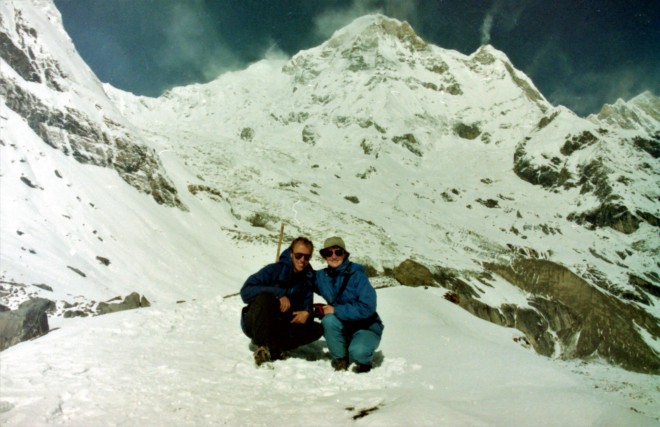
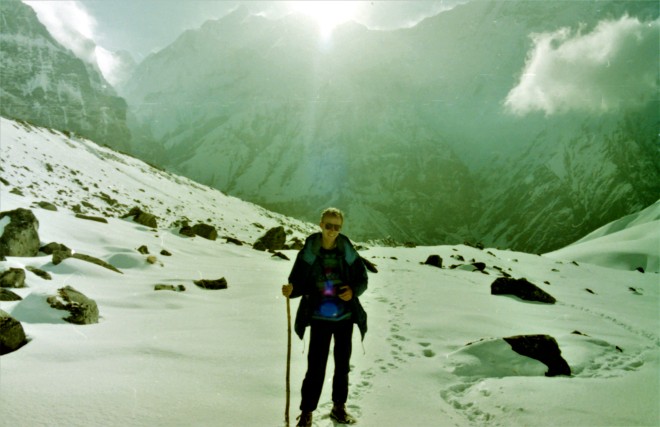
That was Nepal!! Pretty memorable eh!?



































































































